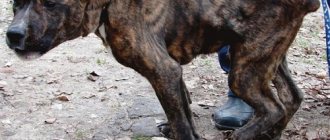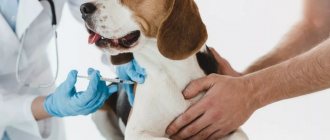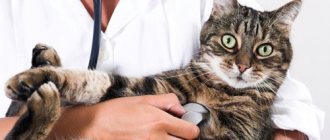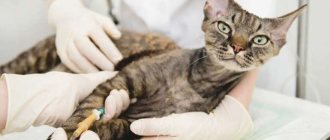Owners of cats and dogs should know the main symptoms of dangerous viral infections in animals in order to begin treatment on time. These infections are the result of penetration of a pathogenic agent into the body of an animal, the reproduction and spread of which causes disruption of the functions of certain organs and tissues. At the same time, the animal's immune system strengthens its defense mechanisms, neutralizing the virus and its toxic waste, which leads to recovery. When the strength of the immune reaction is insufficient, the body weakens and dies.
A sick pet should be taken to a veterinarian immediately
Common infections for dogs and cats
All viral infections are characterized by an incubation period that lasts from several days to months. The insidiousness of some diseases lies in their latent (hidden) form, in which a clinically healthy animal is capable of infecting other individuals.
Rabies
When talking about viral infections in cats and dogs, the most dangerous and incurable disease – rabies – should come first. It is characterized by severe damage to the central nervous system and has almost 100% mortality.
Infection occurs during the bite of a sick animal from a healthy animal, as well as when saliva containing the virus comes into contact with wounds or mucous membranes.
Symptoms
The incubation (latent) period of rabies ranges from two to ten weeks. Most often in animals there is a violent form, quite rarely - a quiet or paralytic form.
The violent form occurs in three stages:
- The precursor stage is characterized by an unreasonable change in behavioral reactions. The animal begins to treat its owner with caution or excessive affection, strives to find a secluded place, catches non-existent insects, and cannot lie in one position for a long time. The pet experiences a perversion of appetite, photophobia and hydrophobia, and may experience vomiting and increased salivation.
- The second phase is characterized by increasing signs of aggressiveness, expressed in tearing various objects and parts of one’s own body with teeth. Even a previously controlled and affectionate animal begins to rush at other individuals and humans, and run away from home. Developing muscle paralysis leads to sagging of the lower jaw, prolapse of the tongue, constant excessive drooling, and strabismus.
- At the third stage, aggression gives way to depression, the animal becomes weak and exhausted. Temperatures drop below normal, and death occurs within 3-5 days.
When the silent form develops, the first two stages are absent.
Treatment
There is no treatment for rabies. In rare cases, highly valuable representatives of certain breeds of dogs and cats are vaccinated with hyperimmune serum and rabies vaccine. However, they are only effective during the incubation period. During the period of pronounced clinical signs, their effect is powerless.
Aujeszky's disease
Characteristic symptoms are:
- Increasing anxiety of the animal, a significant increase in temperature, increased breathing and severe itching at the sites of introduction of the infectious agent. Dogs and cats scratch and chew at itchy areas of the body, rubbing them against various surfaces, resulting in scratches and open wounds.
- Next, animals develop a need for constant movement. They begin to run aimlessly, chew hard objects, roll on the floor, show aggression towards other pets, but do not attack humans.
- Due to increased thirst, foamy saliva accumulates on the lips, but the lower jaw does not sag, as with rabies.
- By the end of 1-2 days, paralysis and convulsions begin, which are harbingers of the death of the animal.
The main treatment comes down to the timely administration of specific globulin when the first signs appear.
To prevent bacterial infection, sick dogs and cats are prescribed antibiotics. Symptomatic treatment is also used, aimed at reducing body temperature and nervous excitement, maintaining the functioning of the cardiovascular system, and relieving convulsive phenomena.
Calicivirus
The disease affects the respiratory system. They get sick during the cold months. The disease is characterized by the following symptoms:
- The causative agent is calicivirus.
- Carriers are sick cats, virus carriers.
- Infection is through the air and by contact.
- The incubation period is 1...3 days.
- Symptoms resemble those of rhinotracheitis. Calicivirus is complicated by stomatitis, diseases of vision and breathing. The disease lasts 7...21 days. Mortality - 30%.
- Diagnosis - clinic, epizootic situation, blood tests. Anemia and leukopenia are observed.
- Treatment is symptomatic. Apply:
- Universal antibiotics.
- Sulfonamides.
- Nitrofurans.
- Vitamins A, C, B12.
- Hyperimmune serum.
- Dietary nutrition, as for leukopenia.
- Prevention - vaccination.
Calicivirus
Viral diseases of cats
Clinicians note that a peculiarity of the course of viral infections in cats is their transition to a state of virus carriage. That is, chronic viral infections of cats are present in the animal’s body until the end of life, even in the complete absence of clinical signs.
Such diseases include:
- feline viral immunodeficiency;
- feline viral leukemia;
- infectious panleukopenia;
- herpes;
- rotavirus enteritis;
- infectious rhinotracheitis;
- calcivirus infection;
- coronavirus infections.
Feline viral immunodeficiency
To treat this viral infection in cats, you need to know the symptoms. Signs do not have their own specificity:
- decreased physical activity;
- lethargy;
- weight loss due to decreased appetite;
- conjunctivitis;
- lesions of the mucous membranes of the oral cavity;
- increased body temperature;
- intoxication phenomena;
- dermatitis;
- increased salivation and lacrimation;
- bleeding from the nasal cavity.
Gradually, the symptoms fade, and a long latent phase begins, lasting from 3 to 5 years. During this time, the concentration of the virus in the blood increases so much that immune cells become unable to contain their destructive effects. The disease enters the final stage, in which the penetration of even a weak pathogenic microorganism leads to death.
Treatment boils down to:
- providing the cat with optimal living conditions;
- limiting contact with other animals;
- carrying out timely deworming and treatment against fleas, ticks and other skin parasites.
A special vaccine against FIV has been developed. However, it is effective against only some strains of the virus.
Feline viral leukemia
The insidiousness of leukemia lies in the long incubation period, during which the retrovirus develops without clinical signs. However, the animal is capable of infecting other individuals by excreting the pathogen in saliva, urine, feces and milk.
After the virus enters the body, the cat gradually suffers damage to the lymph nodes and blood vessels. If the disease is detected at this stage, the process can be stopped using conservative methods. But if cancer cells penetrate the bone marrow, then death is inevitable.
There are several nonspecific signs that indirectly indicate leukemia. These include:
- prolonged increase in temperature;
- appetite suppression;
- lethargy;
- digestive disorders;
- lacrimation;
- sneezing;
- rash on the skin;
- enlarged lymph nodes.
If you detect at least a few of the above symptoms, you must contact your veterinarian to establish an accurate diagnosis.
Treatment is reduced to maintenance therapy, according to the clinical picture. Most often it includes antibiotics, antiviral drugs, immunomodulators and vitamin complexes.
In some clinics, doctors prescribe radiation and chemotherapy, between courses of which blood transfusions are necessary.
You can prevent the occurrence of leukemia by vaccinating your animal annually. However, it should be borne in mind that it reduces the risk of infection, but cannot completely eliminate it.
Infectious panleukopenia
This disease is more often called feline distemper. It affects mainly young animals and has a high mortality rate. But with severe infection, not only the kitten, but also the adult can die.
The fulminant form is characterized by the sudden death of a pet, without the prior appearance of a clinical picture.
Symptoms of the acute form:
- A sharp temperature jump to 41°C, the animal becomes lethargic and refuses the offered food. The vomit has a yellowish tint and contains mucus. A characteristic symptom is diarrhea; the stool has a foul, putrid odor and contains streaks of blood.
- The skin form is characterized by the appearance of reddish spots. In their place, pustules quickly appear filled with serous exudate, which dry out and form crusts.
- Cats develop mucopurulent discharge from the eyes, the heart rhythm is disturbed, and a need for privacy arises.
In the subacute form, the mortality rate sharply decreases. But cats that have recovered from the disease become lifelong carriers of the virus.
Vitafel, which contains immunoglobulins from animals that have already recovered from the disease, is currently successfully used to treat panleukopenia. Good results are obtained by combining this drug with Maxidin or Gamavit, which stimulate the production of macrophages and the synthesis of interferon. You can also increase the body's defenses with the help of a vitamin and mineral complex for cats containing iron, potassium, sodium and calcium.
Fosprenil drops are used as local medications for damage to the eyes and upper respiratory tract.
From the first day, the sick pet is put on a starvation diet. When vomiting, adult animals are prescribed intramuscular injections of Cerucal. Enterosgel is used as an intestinal adsorbent. For the purpose of dehydration, saline solution with glucose is injected intravenously or subcutaneously. To maintain normal functioning of the heart muscle, the doctor prescribes Cordiamin or other heart medications.
To prevent complications of the disease due to bacterial microflora, antibiotics are prescribed.
Herpes
Chronic viral infections of cats include diseases such as herpes. Main symptoms:
- depressed state;
- decreased appetite;
- purulent lesions of the conjunctiva of the eyes;
- keratitis;
- gastrointestinal disorders;
- stomatitis.
With severe infection, cases of pneumonia and encephalitis have occurred.
In clinical practice, cases of asymptomatic herpes have been recorded, after which the disease becomes latent. From such cats, kittens become infected in utero.
Herpes in cats should be treated with Fosprenil or Maxidin, which, according to statistics, ensure recovery on the eighth day after the start of antiviral therapy. For greater effectiveness, these medications should be combined with vitamin complexes and immunostimulants. For diarrhea, veterinarians recommend giving Enterosgel.
A timely introduction of the subunit oil vaccine "Rhone-Mérier" will help prevent animals from becoming infected with the herpes virus.
Infectious rhinotracheitis
The herpes virus is also the culprit in causing rhinotracheitis in cats. Entering the animal's body through the respiratory tract, the pathogen causes damage to the mucous membranes of the oral and nasal cavities, and organs of vision. Keratoconjunctivitis or pneumonia may occur as complications.
Main symptoms:
- photophobia;
- fever;
- profuse drooling;
- discharge of purulent exudate from the eyes and nasal passages;
- ulcerative stomatitis;
- inactivity;
- refusal of food.
The highest mortality rate is observed in kittens under six months of age. Adult cats mostly recover in the absence of complications caused by the penetration of other pathogenic microorganisms. After recovery, animals become lifelong virus carriers.
Antiviral drugs Maxidin or Vitafel are used for treatment. For nose and eye drops, it is best to use Fosprenil. To eliminate pyogenic microflora, the animal is prescribed Ampicillin or Tetracycline.
As a specific treatment, the doctor prescribes the administration of serum against the herpes virus.
Rotavirus enteritis
Rotavirus under high magnification
Rotavirus infection affects the epithelial cells of the small intestine, as a result of which normal absorption of nutrients and water stops, food stagnates, and fermentation and putrefactive processes begin.
Mostly small kittens suffer from this disease. In adults, clinical signs may appear against the background of a sharp decrease in immunity.
Severe pain in the abdomen causes the kitten to panic. In this case, a sharp jump in temperature occurs, vomiting and diarrhea are observed. The stool is frequent, liquid, containing strands of mucus and blood. In severe cases, epithelial detachment and perforation of the intestinal walls occur. Death occurs as a result of severe dehydration or peritonitis.
No specific treatment has been developed for rotavirus infection in cats. Therefore, symptomatic therapy is carried out aimed at accelerating the elimination of the virus, preventing dehydration and severe blood thickening, maintaining heart function and strengthening the body’s immune response.
Calcivirus infection
Infection with calcivirus occurs when the virus enters the mucous membranes of the respiratory tract of animals. After penetration, it migrates to the epithelial tissues of the nasopharynx and submandibular lymph nodes. Clinically this manifests itself as:
- characteristic ulcerations on the oral mucosa;
- serous conjunctivitis;
- excessive protrusion of the third eyelid;
- anemia of visible mucous membranes;
- rhinitis;
- refusal of food.
There are atypical strains of calciviruses that do not affect the organs of vision and breathing. Instead, they cause lameness. In this case, only a veterinarian can make an accurate diagnosis.
Treatment boils down to the use of antiviral drugs and antibiotics, washing the eyes with Fosprenil. For neurological symptoms, the use of Cerebrolysin has a good effect.
Coronavirus infections: enteritis and peritonitis
Coronavirus enteritis in young individuals is mild, manifested by vomiting, diarrhea, fever and abdominal distension. Symptomatic treatment consists of eliminating vomiting with Cerucal injections, drinking Enterosgel, and intravenous administration of saline with glucose. In most cases, the disease ends within 3-4 days.
In adult animals, coronavirus enteritis is asymptomatic. The exception is weakened, exhausted or recently ill pets.
But with infectious peritonitis, the mortality rate is almost 100%. Although the use of modern antiviral drugs reduces this percentage, provided that symptoms are detected early and treatment is started in the first hours of the disease.
Clinical signs of coronavirus peritonitis include:
- temperature rise above 40°C;
- vomit;
- diarrhea;
- bloating;
- intermittent breathing;
- tachycardia;
- anemia (pallor) of the mucous membranes and skin.
In addition to antiviral therapy, for coronary infections, Enterosgel, administration of cardiac drugs, saline, glucose and Cerucal are prescribed.
In some cases, coronavirus can cause damage to the central nervous system, which manifests itself as convulsions and paralysis, leading to death.
Coronavirus peritonitis
Presents a problem for fellinologists running a nursery. Among the many relatively harmless coronaviruses is a deadly one. The disease is difficult to diagnose. It resembles diseases of the brain, eyes, digestive organs and cardiovascular pathologies. Young animals up to two years old and old cats are affected. Mortality is high. The disease is characterized by the following symptoms:
- The causative agent is the FIP coronavirus.
- Carriers are sick and recovered cats.
- Infection - through the air, discharge from the genitals, nose, eyes. Infection is transmitted through food, contact between people and insects.
- The incubation period is 21 days.
- Symptoms:
- Temperature >40°C.
- Symptoms of peritonitis.
- Vomit.
- Ascites.
- The stomach is swollen.
- Treatment is symptomatic. Universal antibiotics are used to destroy the accompanying microflora.
- Prevention. Not developed.
Coronavirus peritonitis
Dog diseases caused by viruses
Viral infections of dogs do not become chronic, but have a high mortality rate. The most common diseases are:
- enteritis;
- hepatitis;
- carnivore plague.
Enteritis in dogs
Enteritis primarily affects puppies and young dogs under three years of age. Signs of the disease include:
- refusal of food;
- lethargy;
- vomit;
- diarrhea;
- bloating;
- increase in body temperature above 41°C.
The dog's feces have a fetid odor of rotten eggs and contain impurities of mucus, strands of blood and epithelium.
If the virus infects the heart muscle, death occurs suddenly. The puppies begin to scream loudly and die from suffocation.
In the fulminant and hyperacute form, the mortality rate ranges from 95 to 100%. In other cases, timely treatment started at home before the doctor arrives can save the pet’s life.
Since there are no specific drugs to combat this infection, symptomatic therapy is used, aimed at mechanically washing out the virus from the intestines using an enema, reducing intoxication with Enterosgel, reducing vomiting (Cerucal), maintaining the functioning of the cardiovascular system (Caffeine, Cordiamine) . Since in most cases death occurs due to dehydration, it is necessary to administer saline solution with added glucose intravenously or subcutaneously 3 times a day. After the vomiting stops, the dog should be given an infusion of herbs (chamomile, sage, oak bark) or sweetened black tea.
Infectious canine hepatitis
This disease is manifested by a sharp increase in temperature, refusal to eat food, vomiting, and diarrhea. In this case, the animal experiences severe thirst and is in a depressed state. Further, yellowness of the mucous membranes, rhinitis, and pain in the right hypochondrium are observed. Urine takes on the color of dark beer. The acute form of hepatitis is fatal in most cases. With a prolonged course, nervous phenomena and paralysis are observed, and keratitis develops in dogs. Abortions occur in pregnant females.
As treatment, animals are given injections of vitamin B12, folic acid is added to the feed, Enterosgel is given to them, and a solution of glucose and sodium chloride is administered intravenously.
Herpes
The disease is characterized by the following symptoms:
- The causative agent is the herpes virus.
- Transmitted intraplacentally.
- The incubation period is 3 days.
- Symptoms:
- Depression.
- Purulent conjunctivitis.
- Keratitis.
- Yellow-green diarrhea.
- Ulcerative stomatitis.
- Pneumonia.
- Stillbirth.
- Treatment is symptomatic.
- Prevention - vaccination.
We invite you to join our Zen channel and group on VKontakte or Odnoklassniki, where new articles for pet owners are published.
Similar articles:
- If your cat has food allergies
- Ringworm Caution: What Pet Owners Need to Know
- Why are cats overweight?
Infectious feline pancreatitis
This is a deadly disease that especially threatens those cats that are kept collectively, that is, they are not the only ones in the house. This means that the greatest risks exist for shelters, nurseries, or simply numerous cats that are kept in one house or apartment.
The insidiousness of the virus that serves as the source of the disease is that it easily degenerates from a form that is not life-threatening to a cat, into a form that poses a mortal threat to the life of the cat. At the same time, it is possible to determine the fact of transition from one form to another when it is too late.
An accurate diagnosis can be made solely based on test results, since infectious feline pancreatitis can easily be confused with various diseases: cardiovascular, gastrointestinal, musculoskeletal.
Unfortunately, today there is no guaranteed method of treating this disease, and the vaccine against this disease is practically useless; scientists are even inclined to believe that this vaccine is harmful.
Rabies
The disease is known, although in veterinary practice it is rarely encountered (much to the happiness of doctors). The pathology is caused by a virus. After the first symptoms appear, therapy is impossible, the animal is doomed. Transmission of the pathogen occurs through the bites of sick animals. Since the virus spreads along the nerve trunks towards the brain, the location of the bite directly affects the likelihood of survival. The closer it is to the head, the lower your cat's chances. In addition, cats are small creatures, and therefore the pathogen moves faster along their nerve trunks. So in most cases, the first clinical signs develop within three to five days from the moment of the bite. The only reliable means of prevention is vaccination (which many owners neglect).
Attention! If you see any clinical signs in your pet, at least similar to those described by us, immediately isolate the cat in a separate room and call a veterinarian! Rabies is an incurable and deadly disease for humans. There is no need to forget about this.
The “clinic” depends on the immediate form of the pathology, of which there are two: violent and quiet. In the first case, the cat becomes extremely aggressive and attacks all people and other animals. Please note that all this happens in complete silence; the rabid pet does not make a sound. He begins to be terrified of water and eat inedible objects (even to the point of swallowing sawdust and pieces of brick). In a quiet form, everything looks much more harmless. The cat, even if in the recent past was very aggressive and “characteristic,” becomes very affectionate. Saliva in such animals, as a rule, is also secreted, albeit in smaller volumes. Cats infected with a silent form of rabies easily “gain trust” in people and bite them. Often a person finds out about his illness only when nothing can be done to help him. Just like a sick cat, by the way. All rabid animals are euthanized and their bodies are disposed of by burning.
Rhinotracheitis
Infectious (herpesvirus) rhinotracheitis primarily affects the cat's respiratory organs and her eyes. The disease progresses quite quickly and insidiously. At the very beginning, it looks like a common cold, but literally after a couple of days the pet’s health deteriorates greatly, she develops hips, purulent discharge from the eyes, swelling of the mucous membranes, the cat is unable to swallow food and drink, this gives her excruciating pain. When making a diagnosis, a swab from the mouth or a wash from the eyes is examined.
To treat this disease, antibiotics are used, necessarily - medications that can help boost immunity, anti-inflammatory drugs, antitussives, expectorants, drops in the eyes and nose.
Moreover, if the owner seeks help on time, a favorable outcome in the treatment of this disease is quite possible.











